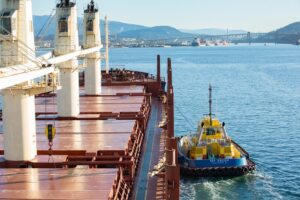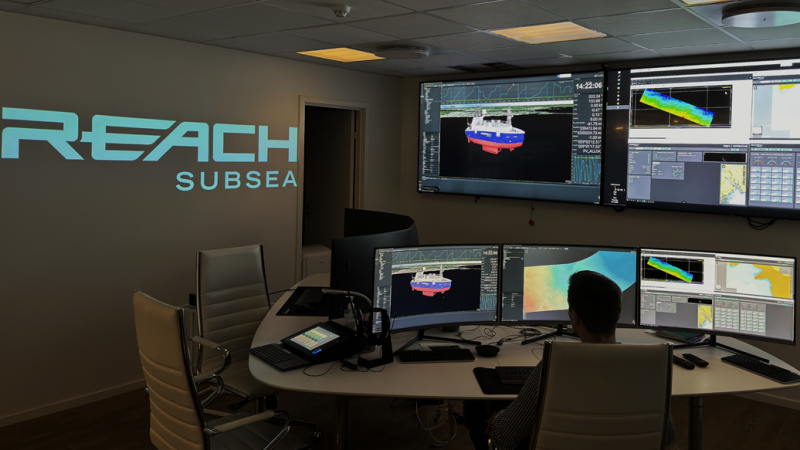SAAM Towage Canada is part of the leading towage operator group in the Americas, SAAM Towage. Based in Chile, SAAM Towage is a division of SAAM Group, the largest operator of towing services in South, Central and North America, which operates more than 180 tugboats in 13 countries
The North American branch, SAAM Towage Canada, employs 150 people and operates 27 tugs in 9 ports of British Columbia, with its main operations located in Vancouver — the largest port in Canada and the most diversified in North America.

Available 24 hours a day, the company has local marine professionals who respond quickly to customer and operational needs to ensure an immediate local response to any event or activity, be it harbour towage, oil and gas terminal towage, offshore or special services to reduce the impact of marine incidents.
“Being the leading towage experts on Canada’s west coast, we help companies safely transport their products in and out of ports in British Columbia— including oil and gas docking services.” said Sander Bikkers. ”Our vision is to stand out as ONE team, delivering safe towage services to all clients, beyond their expectations.”
He remarked that the company draws on extensive experience going back 70 years, having grown through acquisitions, a process he was personally involved in four years ago. Appointed SAAM Towage Canada President in 2019, he oversaw the merger of the two predecessors of the current business.
Under the new ownership, the business has grown further – last year SAAM Towage Canada announced another acquisition of two towage companies in British Columbia, continuing to consolidate its leadership position on the west coast.
The green way forward
As SAAM Towage Canada operates within the traditional, ancestral and unceded territories of various indigenous groups in the country, the company remains committed to developing and maintaining meaningful and respectful relationships with local communities, committed to collaborating with the First Nations to develop long-term, sustainable economic benefits for local communities.
The company is also fully committed to securing greener operations, affirms Mr Bikkers. “Towage is a traditional industry, but we as a company have chosen a very innovative approach, as evidenced by adding two 100% electric tugs to our fleet, set to be delivered during the second half of 2023.”
We wanted our next harbour towage tug to be green. In the end, we found customers who didn’t only talk the talk, but also walk the talk, who made it possible for us to go ahead.”
In October 2022, SAAM Towage reached an important milestone by concluding an agreement with Teck, one of the most prestigious global mining companies, and Neptune Terminals, a bulk shipping terminal located in the port of Vancouver, that will allow the deployment of the first two 100% electric tugs to its fleet. This is the start of a new era for the company, focused on significantly reducing greenhouse gases and underwater noise.
 The tugboats are powered by two separate battery Li-ion energy storage systems, making them 100% electric and zero-emissions ships. They will be charged by British Columbia’s hydroelectric power grid. At full capacity, the new units will save 2,400 tonnes of greenhouse gases each year.
The tugboats are powered by two separate battery Li-ion energy storage systems, making them 100% electric and zero-emissions ships. They will be charged by British Columbia’s hydroelectric power grid. At full capacity, the new units will save 2,400 tonnes of greenhouse gases each year.
“With Teck and Neptune Terminals, SAAM Towage has found value-aligned partners who want to drive sustainable environmental changes through innovation,” said Sander Bikkers. “This alliance is significant for both companies, as it gives financial and technical viability to a common strategic objective: to drive innovation and development for an increasingly sustainable operation.”
“This is one of the ways we want to continue projecting SAAM Towage’s presence in Canada into the future”
Setting an example
This will not be an easy quest, he admits. “We operate in a very capital-intensive environment. Energy in the harbour is not an issue for us, 98% of the energy we use is sustainable, carbon-free. The problem is the assets – we operate capital-intensive assets, i.e. boats, and to make them green, you have to find alternative sources of energy. Electric drive is the obvious solution for smaller boats; for larger boats, this would be methanol or ammonia. But the technology is not there yet.”
“There needs to be a stronger push for cleaner engines in the maritime sector from society in general and from governments. Tugboats are amongst the heaviest polluters in any harbour area. Wherever we operate, the port is in the heart of the community, where everybody lives, works and plays. And yet the tugboats constantly churn carbon exhausts into the air. But there are no public schemes or grants to support the switch to more environmentally friendly, cleaner (and much more expensive) technologies.”
SAAM Towage Canada is thus setting an example of how a very traditional, capital-intensive sector can become greener. “We have found a way to actually drive that change, to set new standards by bringing clients together to support a more sustainable solution,” said Mr Bikkers, who is determined to continue to push that change further.







